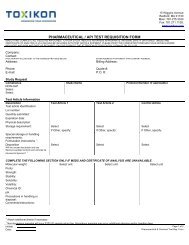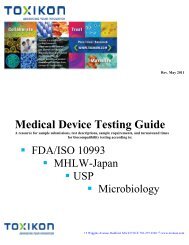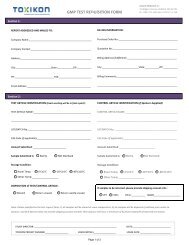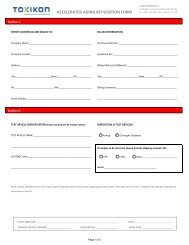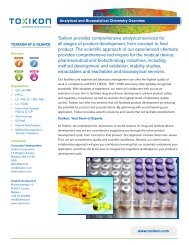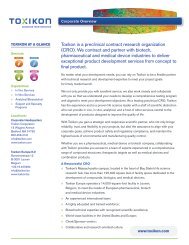Biocompatibility Safety Assessment of Medical Devices ... - Toxikon
Biocompatibility Safety Assessment of Medical Devices ... - Toxikon
Biocompatibility Safety Assessment of Medical Devices ... - Toxikon
Create successful ePaper yourself
Turn your PDF publications into a flip-book with our unique Google optimized e-Paper software.
control sites is conducted by a trained technician. The major differences between the ISO<br />
and MHW procedures are described in Table V.<br />
SYSTEMIC TOXICITY AND PYROGENICITY TESTING<br />
The release <strong>of</strong> the chemical constituents <strong>of</strong> a medical device, either by leaching or<br />
breakdown <strong>of</strong> the device, into the body has the potential for systemic toxicity. Systemic<br />
toxicity tests are generally conducted by administering the extracts (polar and nonpolar in<br />
most cases) as a single dose to test animals, and the health status <strong>of</strong> the animals is verified<br />
periodically—typically 24, 48 and 72 hours after dosing. Control animals are<br />
administered the extraction vehicle. ISO 10993-11, "Tests for Systemic Toxicity," is a<br />
melding <strong>of</strong> ASTM F750, "Standard Practice for Evaluation <strong>of</strong> Material Extracts by<br />
Systemic Injection in Mice (Method A: Intravenous)," and the USP test procedure "<br />
Biological Reactivity Tests, In Vivo," to determine systemic toxicity. 7,8 Differences<br />
between the procedures are minor, mainly in the grading scale used for evaluating the test<br />
and the requirement for necropsy and photographs for the MHLW guideline. Systemic<br />
toxicity test grading scales for scoring responses <strong>of</strong> test animals are slightly different and<br />
are specified within the documents (see Table VI). ISO defines the clinical observation<br />
descriptors to which would be evaluated for severity ranging from respiratory, motor<br />
activities, convulsion, reflexes, ocular signs, cardiovascular signs, salivation,<br />
Piloerection, analgesia, muscle tone, gastrointestinal and skin.<br />
Table VI<br />
9



